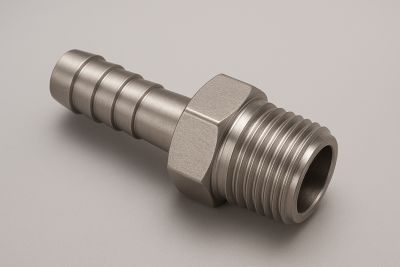Hydraulic systems are the unseen force behind countless machines we rely on every day—from excavators lifting tons of earth to aircraft landing safely on runways. These systems use pressurized fluid to transfer power, offering unmatched efficiency and precision. To keep them operating smoothly, every component must be reliable, from large pumps and cylinders to the smallest connectors.
Among these smaller parts, fittings and adapters play a vital role. They ensure fluid can travel safely from one part of the system to another without leaks or failures. One such unassuming yet critical component is the straight barbed hose adapter, a connector that ensures hoses remain securely attached under high-pressure conditions.
What is a Straight Barbed Hose Adapter?
A straight barbed hose adapter is a type of connector designed to link flexible hoses to other hydraulic components.
➡️ Design: As the name suggests, it has a straight body. One end is barbed, featuring ridges or grooves that grip the inner wall of a hose, preventing it from slipping off. The opposite end may be threaded, smooth, or designed to connect to another fitting or device.
➡️ Materials: These adapters are manufactured from materials such as brass, stainless steel, aluminum, or durable plastics, depending on the system’s pressure requirements and environmental conditions.
➡️ Comparison: Unlike elbow adapters, which allow angled connections, or quick-connect fittings, which are designed for frequent disconnection, straight barbed hose adapters provide a simple, permanent, and reliable connection.
Core Functions in Hydraulic Systems
Straight barbed hose adapters may look simple, but their functions are critical:
1. Secure Hose Connection: The barbs dig into the inner lining of the hose, ensuring it stays in place even under vibration or pressure spikes.
2. Leak Prevention: The ridges also help form a seal, reducing the risk of fluid leaks that could lead to inefficiency or hazards.
3. Pressure Handling: While not suited for extreme pressures compared to specialized fittings, barbed adapters can reliably handle a wide range of hydraulic applications.
4. Versatility: Available in different diameters and thread types, they allow compatibility across hoses and system components.
Advantages of Using Straight Barbed Hose Adapters
1. Cost-effective and easy to install – They don’t require specialized tools or complex assembly.
2. Minimal tools required – Often, just pushing the hose onto the barb and securing it with a clamp is enough.
3. Wide compatibility – They can be used with many types of hoses and tubing.
4. Durability – Made from robust materials, they withstand demanding industrial conditions.
Applications in Hydraulic Systems
Straight barbed hose adapters are found across industries:
➡️ Heavy machinery: Excavators, tractors, and mining equipment rely on them to keep hydraulic hoses securely connected.
➡️ Automotive hydraulics: Brake lines, fuel systems, and power steering often use barbed adapters for reliable connections.
➡️ Industrial equipment: Compressors, pumps, and presses use them for fluid transfer.
➡️ Marine and aerospace: Their durability and simplicity make them suitable for high-demand environments where safety is paramount.
Best Practices for Installation
For long-lasting performance:
➡️ Select the correct size and material – Match the adapter to both the hose diameter and the fluid type.
➡️ Prepare the hose properly – Cut it cleanly, remove debris, and inspect for cracks.
➡️ Ensure a tight fit – Use clamps when required, especially in higher-pressure systems.
➡️ Prioritize safety – Always depressurize the system before working and wear proper protective equipment.
Maintenance and Troubleshooting
Even simple parts need attention:
➡️ Regular inspection – Check for corrosion, wear, or fluid leakage.
➡️ Look for signs of poor installation – Loose connections, visible hose gaps, or leaks are red flags.
➡️ Replace when needed – If an adapter shows wear, damage, or fails to seal properly, it should be replaced immediately.
FAQs
Do barbed fittings work with all hoses?
Not all hoses are suitable. Barbed fittings work best with flexible hoses, typically rubber or soft plastic. Rigid or reinforced hoses may require compression or crimped fittings.
Are barbed or compression fittings better?
It depends. Barbed fittings are easier and cheaper to install, while compression fittings offer higher pressure tolerance and a more rigid connection. The choice depends on system requirements.
Conclusion
Straight barbed hose adapters may seem like minor components in a hydraulic system, but their function is indispensable. They secure hoses, prevent leaks, and ensure fluid power systems operate reliably and safely. Their simplicity, affordability, and versatility make them a go-to choice across industries.
By choosing the right adapter, following best installation practices, and performing regular maintenance, operators can extend the life of their hydraulic systems and maintain peak performance.
Post time: Oct-01-2025


